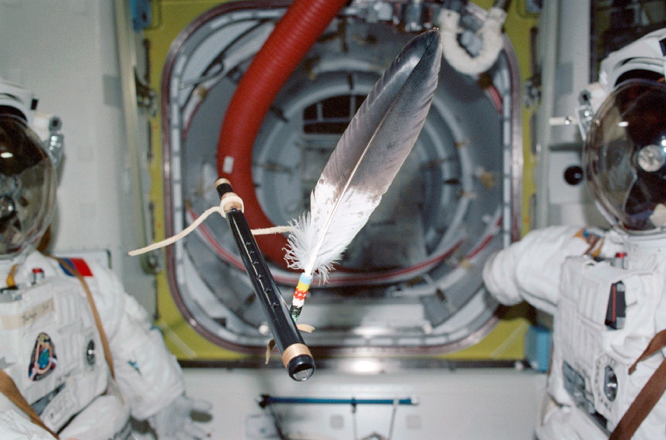From Space to Indigenous Ancestral Engineering: Commander John Herrington Charts New Territory

When NASA sent Commander John Herrington (Chickasaw Nation) to the International Space Station (ISS) on board the Endeavour in 2002, space not only got the first enrolled Native American, but also its first Native American flute payload.

“I played ‘Amazing Grace’ on board the ISS while my crewmate, Don Pettit, used a vacuum cleaner hose to simulate an aboriginal didgeridoo, which he actually brought onboard; he just had not unpacked it yet,” Herrington told Indian Country Today Media Network in a recent interview. “The Native American flute I flew on my mission, a black-lacquered river cane flute, was made by a Cherokee friend, Jim Gilliland.”
RELATED: Native History: Astronaut John B. Herrington, Chickasaw, Becomes First American Indian in Space
Herrington still remembers the thrill of creating those sounds while they were all aboard the ISS as they orbited the Earth over and over again.
“I was honored to have the opportunity to fly in space, but I realize there were thousands of people who made it possible; technicians, engineers, scientists, medical personnel, and administrators,” he said. “Our ability to fly in space and explore is due to the collective efforts of a multitude of talented people, many of them trained in the STEM fields.”
Herrington retired from NASA in 2005. He enjoys seeking new challenges, and last year earned his PhD in education from the University of Idaho.
RELATED: From Walking in Space to Walking at Graduation: Astronaut Gets His PhD
“I like the opportunity to learn new things and to work with interesting people,” he said. “I find tremendous satisfaction in successfully accomplishing difficult tasks. Working hard and working well with others is very gratifying.”
His ideal job?
“When I had a chance to fly, and then being able to come back and really focus on education and work with the students,” he said.
RELATED: First Native Astronaut Tells Students at Hopi High About Space Journeys
His dissertation research focused on the motivation and engagement of Native students in the STEM (Science, Technology, Engineering and Math) fields who had attended a NASA summer program. Native American and Alaskan Natives earned just 0.6 percent of master’s degrees in science and engineering in 2009, according to the National Science Foundation—a dismal statistic that highlights the importance of his research and of his motivation to study different approaches to engage Native students in STEM education.
“I wanted to look at the results of tests they took before and after that summer program,” he said. “I did a case study three years later where I actually interviewed those students to really find out the factors that motivated and engaged them in NASA math and science based on that summer program. I analyzed the pre- and post-tests they took, and I had the students tell me the stories of their experience.
“It was interesting because it supports the literature that I've read, but there's not a lot out there on the factors that motivate Native youth in the STEM subjects,” Herrington continued. “The results of my research indicated that Native students become engaged and motivated through hands-on experiential, non-competitive, collaborative learning. They like to work in groups, they like to build stuff, they like to personalize their work and see the practicality in what they're learning related to the theory.”
In the case of math, Herrington said, it was about being able to visualize math in his job. He worked on a surveying crew and saw the surveyors using math in the work they did, which helped him relate to math’s practical nature.
“I was hanging off a cliff in Colorado, and these guys would shoot a beam of infrared light to a prism I held in my hand,” he said. “Since light travels at a constant velocity, you can determine the distance, if you know how long it took the light to travel from one point to another. If you know the angle of that beam of light, you can determine the horizontal and vertical distance using trigonometry. They used surveying machines that could calculate these things. For the first time in my life I actually saw the practicality of mathematics in work, and it was fun!”
Read more at http://indiancountrytodaymedianetwork.com/2015/06/02/space-indigenous-ancestral-engineering-commander-john-herrington-charts-new-territory